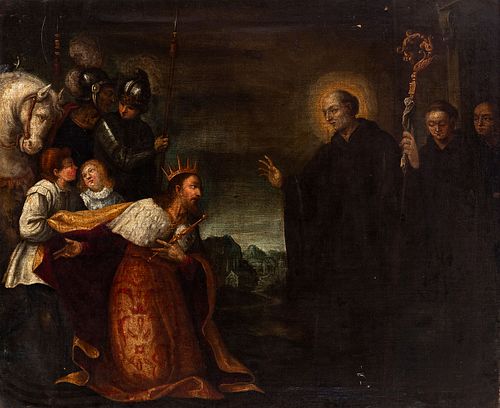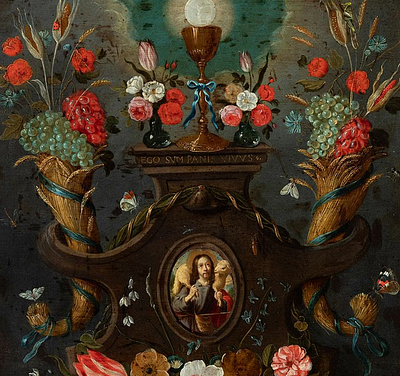Italian school; 17th century. “San Benito y Totila”. Oil on canvas. Re-coloured.
Lot 48
About Seller
Setdart Auction House
Carrer Aragó 346
Barcelona
Spain
Setdart Subastas was born in 2004 and is currently the first online art auction in Spain with solidity, prestige and reliability guaranteed by our more than 60,000 users. Setdart has a young, dynamic and enterprising team ready to successfully manage the purchase and sale of art works through custom...Read more
Estimate:
EUR€2,500 - EUR€3,000
$2,604.17 - $3,125
Absentee vs Live bid
Two ways to bid:
- Leave a max absentee bid and the platform will bid on your behalf up to your maximum bid during the live auction.
- Bid live during the auction and your bids will be submitted real-time to the auctioneer.
Bid Increments
| Price | Bid Increment |
|---|---|
| EUR€0 | EUR€10 |
| EUR€200 | EUR€25 |
| EUR€500 | EUR€50 |
| EUR€1,000 | EUR€100 |
| EUR€3,000 | EUR€200 |
| EUR€5,000 | EUR€500 |
| EUR€10,000 | EUR€1,000 |
| EUR€20,000 | EUR€2,000 |
| EUR€50,000 | EUR€5,000 |
About Auction
By Setdart Auction House
Sep 21, 2021
Set Reminder
2021-09-21 10:00:00
2021-09-21 10:00:00
America/New_York
Bidsquare
Bidsquare : 21st September - ARAS JÁUREGUI Private Collection - Old Masters, 19th & 20th Century
https://www.bidsquare.com/auctions/setdart-auction-house/21st-september---aras-j-uregui-private-collection---old-masters-19th-20th-century-7429
Setdart Auction House sofia@setdart.com
Setdart Auction House sofia@setdart.com
- Lot Description
Italian school; 17th century. “San Benito y Totila”. Oil on canvas. Re-coloured. It has repainting and a slight hole in the canvas. Needs cleaning. It has an Andalusian frame, from the XVII century, with faults in the carving. Measurements: 77,5 x 95 cm; 87 x 104 cm (frame). This work contains the religious story in which the encounter between Saint Benedict and King Tolila is narrated. The fame of Saint Benedict spread to such an extent that the king of the Goths, Tolila, decided to meet the saint and to see for himself the qualities attributed to the saint. For this reason, Totila arranged a visit with the saint. However, he ordered a representative of his court, Riga, to appear before St. Benedict as if he were Benedict himself, to see if the saint truly possessed the gift of prophecy, and divined the deception. When Rigo entered the monastery, Saint Benedict, who was sitting at the door, said to him "Take that off, son, take off that thing you are wearing, it is not yours". After Totila was discovered, he presented himself in the monastery, but embarrassed by his ruse, he did not dare to approach St. Benedict and prostrated himself on the ground. It was then that Saint Benedict approached him, lifted him off the ground, and said to him "You do much harm, it is time for you to put an end to your wickedness", in reference to the bellicose reputation of the Gothic king. In this particular scene, the author shows the moment in which King Totila is prostrate before the saint, after having tried to deceive him. Saint Benedict, on the right of the composition, holds his crosier, while with the other hand he holds out his open palm to the king in an attitude of vehemence. Both figures are accompanied by a retinue, the king's being particularly colourful and the presence of the horse, which shows the artist's interest in demonstrating his technical mastery. Arranged in the form of a frieze, all the figures are in the foreground, leaving a slight space in the centre, which gives depth to the scene by allowing the viewer to observe a landscape conceived through successive planes.
- Shipping Info
-
In-house shipping available. Please inquire at admin@setdart.com.
-
- Buyer's Premium



 EUR
EUR CAD
CAD AUD
AUD GBP
GBP MXN
MXN HKD
HKD CNY
CNY MYR
MYR SEK
SEK SGD
SGD CHF
CHF THB
THB

















